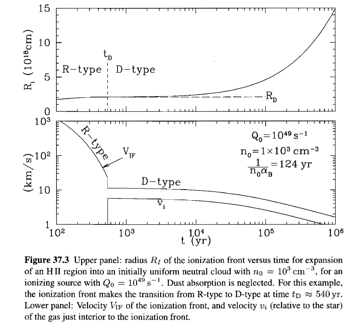(This pages uses MathML and is best viewed in Firefox.)
HII regions are not static; they are dynamic and evolve in time. From the instant when the ionizing star turns on until the time when it dies, we can roughly track the growth of the HII region.
Strömgren Radius
If we could think of HII regions as being static, their size would be given by the Strömgren radius, which gives the distance to the edge of the ionized region. Consider a box of neutral hydrogen with number density nH. At time 0, an ionizing source of luminosity Q is turned on. The radius within which the gas is ionized is known as the Strömgren radius rs. Due to recombination, at distances larger than $l_s$, the medium remains neutral. We can express the Strömgren radius as
Thermal Equilibrium:
All ionizing gas can be shown to be at the equilibrium temperature, since the time to thermal equilibrium is approximately equal to the time to ionize the gas.
Initial ionization front expansion (R-Type):
The ionization front’s location will be dictated in part by the battle between ionization and recombination. These parts are:
*Emitted by ionization: Assume that the number of ionizing photons Ni are produced at a rate Q [photons/second].
*Destroyed by recombination: The ionizing photons are absorbed by recombination out to a radius ri at a rate
Thus the net number of ionizing photons per unit time is given by
We can rewrite the left hand side in terms of the number density and the ionizing volume, allowing us to find the expansion distance as a function of time,
Integrating this expression yields
Thus within the recombination time (trec= 1/nH aB), the expansion proceeds out to roughly the Stromgren radius.
Expansion out to pressure equilibrium (D-Type):
As the gas is ionized out to the Strömgren radius, it undergoes heating and cooling from ionization and recombination. The net result is thermal equilibrium, such that the gas is heated to ~104 K. While the temperature of the ionized gas is greater than the unionized gas, the density stays the same. The pressure within the ionized region is significantly higher than the surrounding medium, thus causing the ionized region to expand. Expansion will continue until pressure equilibrium is reached.
The pressure of the gas inside the ionized region is, by definition,
where cs is the sound speed and ρi is the ionized mass density. This will be in equilibrium with the neutral matter swept up in the shell of the ionization front. Its pressure at a radius ri is
where ρ0 is the initial mass density of the neutral gas. Recall from our derivation for the initial expansion rate that the two densities are related by
Substituting into Pi and equating with Psh gives a differential equation that we can solve by assuming that ri is a power law of t. As our boundary condition, we say that the ionization front reaches the Strömgren radius at a time ts
Thus, we have roughly
The End of Expansion
Expansion ends when pressure equilibrium is reached; in fact as the pressure drops in the HII region and becomes more comparable to the neutral gas, the expansion will slow down. This isn’t accounted for in our calculation above because we neglected the external pressure. While we can calculate the time and radius when this stalling begins, the results will show that the stalling is much larger than the age of the star. Once the star moves off the main sequence, it stops producing ionizing photons, and the HII region can expand no more.

Ionization Front Equations

Ionization front expansion
as a function of time
from Draine Fig 37.3